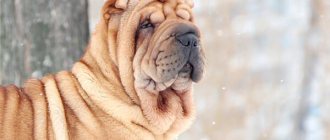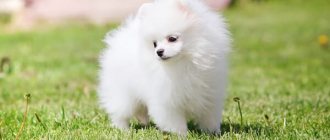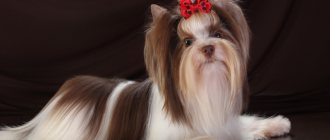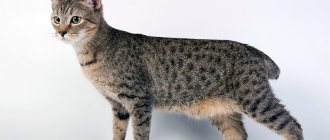The clumsy, funny, clumsy Shar Pei has a heart full of love for the family in which he lives, the makings of a psychologist and nanny, and in dangerous situations he will become a fearless defender.
Cute, unique, numerous folds of skin, varied coat colors and character traits make this dog one of the most popular in the world.
How long do Shar Peis live?
The average lifespan of a purebred Shar Pei is 10 years.
The life expectancy of a Shar Pei living at home is influenced by the following factors:
- Heredity.
- Dimensions. The larger the animal, the more energy the body expends to maintain its vital functions.
- Compliance by owners with the rules of keeping a dog.
- Regularity of sexual activity and number of births for females.
Weight
The weight of these animals ranges from 18 to 25 cm, according to the standard. But in reality it can be much larger, first of all this applies to large and powerful males: Shar Pei weighing 35 kg or more are not uncommon among them .
IMPORTANT! The dog's weight should correspond to its height. A dog can be neither light nor too heavy.
Coat types
Shar Peis have fur that resembles velor, so they are somewhat similar to a plush toy.
Depending on the size of the hairs, dogs of this breed are classified according to their hair type as follows:
Horse hairs up to 1 cm in size. The peculiarity of this type: with increasing age and growth of the puppy, the number of folds decreases.
Brush - hairs up to 2.5 cm long. Decreasing along the length of the body, the folds remain on the muzzle and in the neck area.
Bear hair - hair length more than 3 cm. These individuals do not take part in official exhibitions, due to the fact that bear hair is one of the factors that rejects a dog from a purebred.
Prices for puppies
Shar Pei today is one of the rarest, and therefore expensive, breeds in Russia. Usually, dogs with a rich pedigree from China and Europe, or less often from America, are chosen for breeding. The cost of one puppy greatly depends on its pedigree, class, and compliance with standards. Before purchasing a puppy, it is recommended to consult with the breeder, check the documents, and talk to the puppy yourself.
It is difficult to name the average price; prices for Shar Pei puppies today range from 10 to 30 thousand rubles.
Shar Pei color
In 2005, the Russian Canine Federation approved a register of Shar Pei colors that meet the standards.
The color of the Shar Pei, according to the adopted document, must have the following distinctive features:
- wool is one color. Spots are allowed in white Shar-Peis;
- hind legs are half a tone lighter than the main color;
- the dog's muzzle is slightly darkened;
- A dark stripe in the form of a ribbon is allowed on the back.
It is impossible to describe the entire amazing palette of colors that Shar Peis have. But it is conditionally divided into three parts:
- Main color
- Diluted color
- Unusual color (otherwise called marriage)
The dominant color in the first group is black. Moreover, natural blackness in animals is quite a rare phenomenon. As the puppy grows up, it changes color and instead of black, its coat acquires a brown, brown or olive tint.
The first group includes dogs with the following color scheme:
Cream. Dogs of this color have weak pigmentation; the back, eyes, ears and tail are darker than the main color.
Deer. The oldest color of an animal. A distinctive feature of the wool is a golden shine that shimmers in bright light. As the individual grows older, the color changes to darker.
Red deer. A variety of deer color. Unlike golden fawn, red fawn puppies have dark red or faint light red undertones in their fur.
Isabella. A puppy of this color will win the heart of the owner forever, being the offspring of red and blue specimens, he has a pinkish-cream coat without red pigment with a sky-blue tone.
Red. The most popular tone among breeders. Its varieties are red, red and mahogany tones.
The Blue Shar Pei has an aristocratic appearance. Blue color is a combined concept that includes animal smoky, gray and slate shades.
Sable. At first glance, an animal of this color seems to be sprinkled with grayish pollen, and the spraying was more intense in the areas of the back, tail and muzzle. Taking a closer look, you can see that each hair consists of three parts - light at the bottom, then red, and dark at the tip. The sable color differs from other colors in the presence of zones.
In dilute-colored animals, the black color is completely absent. The group's palette is represented by the following colors:
Cream (creamy shade). Unlike its counterpart from the first group, the cream dilut does not have a dark color on the back and ears, and there is no mask on the face. Their tongue color is lavender and their nose is pink.
Apricot. The color of the fur is golden-red. The play of color from the dark back to the light belly is touching. The pet can be one color. The nose is usually chocolate color.
Red. Dogs of this color have a mask on their muzzle, nose and pads that have a delicate chocolate tint. Regardless of the age of the dog, the color of the dog’s body is uniform.
Chocolate. You can match the animal to the color of your favorite delicacy, due to the fact that the color tone varies from milky to dark. The chocolate dog's tongue is light lilac. If an individual has a blue tongue and a dark color, it is not a chocolate dilute, but a representative of the first group.
Lilac. The dogs are a rare color and have a bluish coating on their faces. Coat color can be chocolate pink, silver pink or dark purple.
Isabella. The rarest color of the Shar Pei, according to the standard a mask is allowed on the face. A characteristic feature of dogs of this shade is the absence of darkening on the back.
Pets of unusual color are called floral, due to the spots they have on their body. Such species are becoming more and more attractive, but are not recognized by all cynological federations. The application submitted to the RKF for inclusion in the register of spotted sharpei colors has not yet received confirmation.
History of the origin of the breed
The Shar Pei is an ancient breed whose homeland is considered to be China. It is believed that it comes from two also now known breeds - the Chow Chow or the Tibetan Mastiff. You can verify the similarity from the photo of the Shar Pei, whose fur is not sufficiently reliable protection against severe cold.
However, compared to the ancient ancestors of the breed, modern dogs look less athletic, they have more folds and have become smaller at the withers.
An interesting fact is that this breed belongs to a group of dogs that differs minimally in DNA from the wolf.
In southern China, Shar Peis were used as working, hunting, and guard dogs. For noble residents, these animals had no value, but due to the elasticity of their skin, they were irreplaceable in hunting - the ease with which Shar-Peis left the mouth of a wolf was simply unique.
This property began to be used in organizing dog fights.
With the change in the political system in China in recent centuries, these dogs were destroyed because they were identified with prosperity. Thanks to the emigrants, the breed was saved.
In the 70s of the last century, active breeding work began in the United States. However, the big disadvantage was that virtually all animals that exist outside of Asia came from the 200 animals that were exported. This had a significant impact on the health of the breed.
The modern American Meat-Mouth breed type differs from its Asian relatives Bone-Mouth. Americans have a more massive head with a greater number of large folds, and the animal itself looks thicker.
The breeders managed to improve the dog’s character by adapting it to the urban environment. But at the same time, there are often cases when Shar Pei puppies have poor health. That is why it is recommended to cooperate only with well-known and trusted nurseries.
Dog character
Behind the sullen and gloomy appearance of the Shar Pei lies friendliness, love, kindness, cheerfulness, and curiosity. In addition, the dog has the qualities of a real psychologist.
The character of the Shar Pei has a desire to be a leader, so the owner of such a dog must have a strong and strong-willed character. It is worth noting that already a four-month-old puppy is well versed in the hierarchical structure of the family where he lives.
He will not obey the children, but at the same time he will not offend them. However, the dog should be taught to communicate with children. Dogs ignore individual family members for the rest of their lives.
The animal's aggressiveness increases significantly if you grab it by the legs or suddenly put your hand on it. This is due to the characteristics of peripheral vision, since due to large eyelids it is very weak.
Animals are highly intelligent. If they find themselves in an extraordinary situation, they will not lose their composure. Being alone in a living space while waiting for a long time for the owner will not damage things and clothes. Shar-Peis living outside the city will not run through flower beds and beds, but will walk along well-trodden paths.
The dog completely adapts its regime to the owner’s daily routine:
- the owner lies down to rest or sits down to work, at this time the Shar Pei will take a nap or lie down on its bedding;
- if the pet sees a leash in the owner’s hands, he rejoices and hurries to go for a walk;
- the dog's morning rise time coincides with the owner's routine;
- if suddenly the owner is overcome by sadness, the dog will grieve with him.
The Chinese Shar Pei tolerates trips and travel well. Although traveling with a dog is a troublesome task, neglecting your pet and not wanting to take it with you will negatively affect its character.
Training
Despite the natural calmness and non-aggressiveness of Shar-Peis, this breed of dog is stubborn, so it is recommended for experienced dog breeders.
From an early age, it is worth gradually socializing the puppy, accustoming it to family members and pets. Starting from 3-4 months, you can gently but persistently accustom the dog to commands in order to smooth out the dominant traits and ensure the dog’s devotion and obedience by a more mature age.
It should be remembered that aggression and physical violence should not be allowed during training. The best option would be to take a training course from a dog handler, however, it is also possible to teach your dog the basic commands “come to me!”, “no!”, “place!” on your own.
In addition to the commands, we must not forget that the Shar Pei should be given the opportunity to communicate with other people and animals as often as possible in order to avoid any aggression on its part in the future.
What should a Shar Pei menu be like?
As with feeding any pets, there is a choice of using dry food for feeding or preparing the food yourself.
Both methods have their advantages and disadvantages. Ready-made food should be premium, with a price tag that weighs enough for the owner’s wallet.
Cooking your own food takes personal time and requires purchasing high quality products.
Therefore, an assessment of financial capabilities is prevalent when deciding to adopt a Shar Pei dog into the family.
The dog does not have a good appetite. Long walks and games in the fresh air will help improve your appetite. The dog needs to be fed twice a day.
The diet must include:
- meat and offal. The main part of the diet, any raw meat is suitable, except pork, chicken and raw liver. The last two products can cause severe allergic reactions;
- fish. Served two to three times a week boiled or stewed. The fish should not be fatty and marine. It is important to remove all the bones from a fish dish before serving.
- milk and dairy products. Only puppies can lap up milk. For an adult dog, kefir, yogurt, and low-fat varieties of cottage cheese are suitable.
- quail eggs. They are given several times a week, two pieces raw, along with the shells.
- cereals The diet will be supplemented with boiled buckwheat, rice, and oatmeal; if the dog is obese, the best option for feeding him would be pearl barley.
An excellent addition to the diet will be vegetables: carrots, pumpkin, zucchini, broccoli.
Vaccinations and susceptibility to disease
Shar Pei puppies are vaccinated with complex vaccines against the most dangerous diseases. The first vaccination is given at 8-9 weeks, the second - after 14-21 days. At about 6 months, when the change of teeth ends, they are vaccinated against rabies. Adult dogs are vaccinated every year.
Shar Peis are quite sickly dogs. They are susceptible to:
- dysplasia of the elbow and hip joints (partial or complete destruction of the joints);
- dislocations of the kneecap (displacement of the kneecap in the femur block);
- osteochondrosis (cartilage degeneration);
- Shar Pei fever (swelling of the hock joint);
- hypothyroidism (lack of thyroid hormones);
- seborrhea (disruption of the formation of horny substance in the cells of the epidermis);
- demodicosis (skin disease caused by mites);
- pyoderma (infectious skin disease);
- cutaneous mucinosis (excessive deposition of mucin in the skin);
- otitis (inflammation of the ear canal);
- Gastric volvulus (twisting of the stomach around the esophagus);
- entropion (incorrect fit of the edge of the upper or lower eyelid to the cornea of the eyeball).
On average, representatives of the breed live 10-12 years.
Shar Pei photos
Muzzle
The standard says that in the Shar Pei it is thick and large, reminiscent of the mouth of a hippopotamus. And this is the most accurate description of the “face” of any of the representatives of this breed.
The Shar Pei's muzzle should be massive and wide, not tapering towards the nose. These dogs have heavy and drooping lips, with the upper one being especially large, thick and voluminous.
Tongue color
In Shar Peis, which belong to the main color group, the color of the tongue can only be bluish-black. In dilute colors, a lighter shade is allowed. The color of the tongue can be seen even in puppies, but some have poorly expressed pigmentation at a young age.
Important! Adult Shar Pei's tongue should be one solid color with no spots.
Shar Peis have many external distinctive features that set the breed apart from the rest. Animal lovers know that the dog with the folds is, of course, the Shar Pei. All distinctive features and characteristics are specified in the breed standard. Any discrepancies do not allow animals to participate in show class exhibitions.











